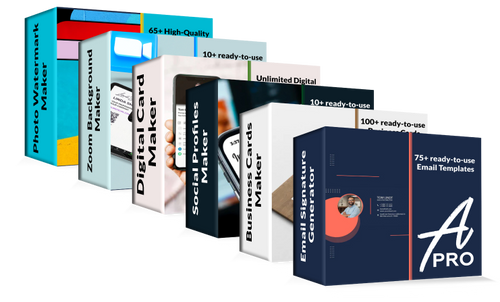For business owners and brand managers striving to craft a compelling brand identity, distinguishing between a logo and an icon is essential. These visual tools, while seemingly similar, serve distinct purposes in your branding strategy. In this article, we explore the fundamental differences between logos and icons, offering insights on their unique roles and best practices for leveraging them to enhance your brand's recognition and user experience.
What Is a Logo?
A logo is a distinctive graphic mark, emblem, or symbol designed to represent a company, organization, product, or brand. It serves as the visual cornerstone of a brand's identity, encapsulating its essence, values, and mission in a single, memorable image. From corporate cards and websites to advertising campaigns and product packaging, logos are painstakingly created to be instantly identifiable and flexible, so guaranteeing they can be utilized effectively across many media. In a competitive market, a well-designed logo distinguishes the company, develops trust, and strengthens visual connection, thereby increasing brand recognition.
What Is an Icon?
An icon is a simplified graphic representation that conveys a specific idea, action, or object, often used within digital interfaces to enhance user experience and navigation. Unlike logos, which capture the essence of a company, icons are practical components meant for fast and effective communication; so, they are perfect for usage in applications, websites, and programs. Icons are typically minimalistic and universally recognizable, ensuring users can easily understand their meaning without the need for text. By providing intuitive visual cues, icons streamline interactions, improve accessibility, and contribute to a seamless and engaging user experience.
Logo vs Icon What’s The Difference?
Purpose
- Logo: Represents the entire brand identity, encapsulating the company's values, mission, and essence in a single, memorable image.
- Icon: Serves a functional purpose, providing visual cues to enhance user experience and navigation within digital interfaces.
Design Complexity
- Logo: Often more complex and detailed, designed to be versatile and recognizable across various mediums, from business cards to billboards.
- Icon: Typically minimalistic and simplified, focusing on clarity and ease of recognition, especially in small sizes.
Usage
- Logo: Used across all brand touchpoints, including marketing materials, websites, social media, product packaging, and corporate stationery.
- Icon: Primarily used within digital platforms such as apps, websites, and software to indicate actions, features, or content categories.
Recognition
- Logo: Aims to build long-term brand recognition and loyalty, creating a strong visual association with the brand.
- Icon: Designed for immediate recognition and understanding, facilitating quick and intuitive interactions.
Flexibility
- Logo: Needs to be adaptable to various contexts and sizes while maintaining its integrity and recognizability.
- Icon: Must be highly adaptable to different screen sizes and resolutions, often used in sets to maintain consistency across a digital interface.
By understanding these key differences, business owners and brand managers can effectively utilize logos and icons to enhance their brand identity, services, and user experience.
Can a Logo Be An Icon and Vice Versa?
A logo can sometimes function as an icon, and vice versa, but this duality requires strategic design to ensure both roles are effectively fulfilled. A logo that doubles as an icon must be simple enough to be instantly recognizable and functional in small sizes, yet distinctive enough to encapsulate the brand's identity and values. Conversely, an icon used as a logo must transcend its typical utilitarian purpose to convey the broader essence of the brand, incorporating careful icon creation to ensure it stands out effectively. This means it should be versatile, memorable, and capable of representing the brand across various platforms and touchpoints. Achieving this balance allows a single design to serve both as a logo and an icon, enhancing brand consistency and recognition.
What Is The Difference Between a Logo and a Symbol?
The difference between a logo and a symbol lies primarily in their scope and function within branding and communication. A logo is a complete visual depiction of a brand including its identity, values, and mission in an arresting and memorable design. Often including graphic components, it also incorporates text elements—such as the brand name or tagline—which guarantees its adaptability and recognition across several media. In contrast, a symbol is a more abstract and simplified graphic element that conveys a specific idea, concept, or object without the need for accompanying text. While a logo serves as the face of the brand, aiming to build long-term recognition and loyalty, a symbol is often used to represent broader concepts or to provide visual shorthand in communication, often leveraging iconography. Symbols can be part of a logo, but they do not carry the same comprehensive brand identity that a logo does.
What Are the Best Practices for Designing Logos and Icons?
- Simplicity: Keep designs clean and straightforward to ensure they are easily recognizable and versatile.
- Scalability: Ensure designs look good at various sizes, from small icons on a mobile app to large logos on billboards.
- Relevance: Align the design with the brand’s identity, values, and target audience to create a meaningful connection.
- Memorability: Create distinctive and unique designs that leave a lasting impression and are easily recalled.
- Versatility: Design logos and icons to work across different mediums and contexts, including digital and print.
- Consistency: Maintain a cohesive style that aligns with the overall brand aesthetic and other visual elements.
- Timelessness: Avoid trends that may quickly become outdated; aim for a classic design that remains relevant over time.
- Color and Typography: Use colors and fonts that reflect the brand’s personality and ensure readability and visual appeal.
- Functionality: For icons, ensure they effectively communicate their intended action or purpose without the need for text.
- Testing: Test designs in various contexts and sizes to ensure they perform well and are easily understood by the target audience.
How To Choose Between a Logo vs Icon For Your Brand
Choosing between a logo and an icon for your brand depends on your specific branding needs and the contexts in which these visual elements will be used. A logo is ideal if you need a comprehensive representation of your brand that encapsulates its identity, values, and mission. It is versatile and can be used across various touchpoints, from business cards and websites to advertising campaigns and product packaging. On the other hand, an icon is more suitable for functional purposes, particularly within digital interfaces where quick recognition and ease of use are paramount. Icons are perfect for apps, websites, and software, providing intuitive visual cues that enhance user experience and navigation. If your brand requires a strong, overarching visual identity, a logo is the way to go. However, if you need simple, functional graphics to improve usability, icons are the better choice. In some cases, integrating both can provide a cohesive and effective branding strategy, leveraging the strengths of each to enhance overall brand recognition and user engagement.
Conclusion
In conclusion, understanding the distinct roles and characteristics of logos and icons is essential for crafting a compelling brand identity. While logos serve as the comprehensive visual representation of a brand, encapsulating its essence and values, icons provide functional, intuitive cues that enhance user experience within digital interfaces. By recognizing when and how to use each, business owners, entrepreneurs, and brand managers can make informed decisions that elevate their branding efforts. Whether you decide on a logo, an icon, or both, the secret is to make sure your visual components are straightforward, unforgettable, and consistent with the character of your brand, thereby encouraging familiarity and loyalty among your audience.
Final Thoughts
Boost your personal branding with Artlogo. We excel in crafting unique branding elements, including handwritten signatures, business cards, and social media icons, designed to make your business memorable. Our innovative solutions ensure your brand distinguishes itself in a competitive landscape. Explore Artlogo today to elevate your brand presence.
Sources



























Share to: